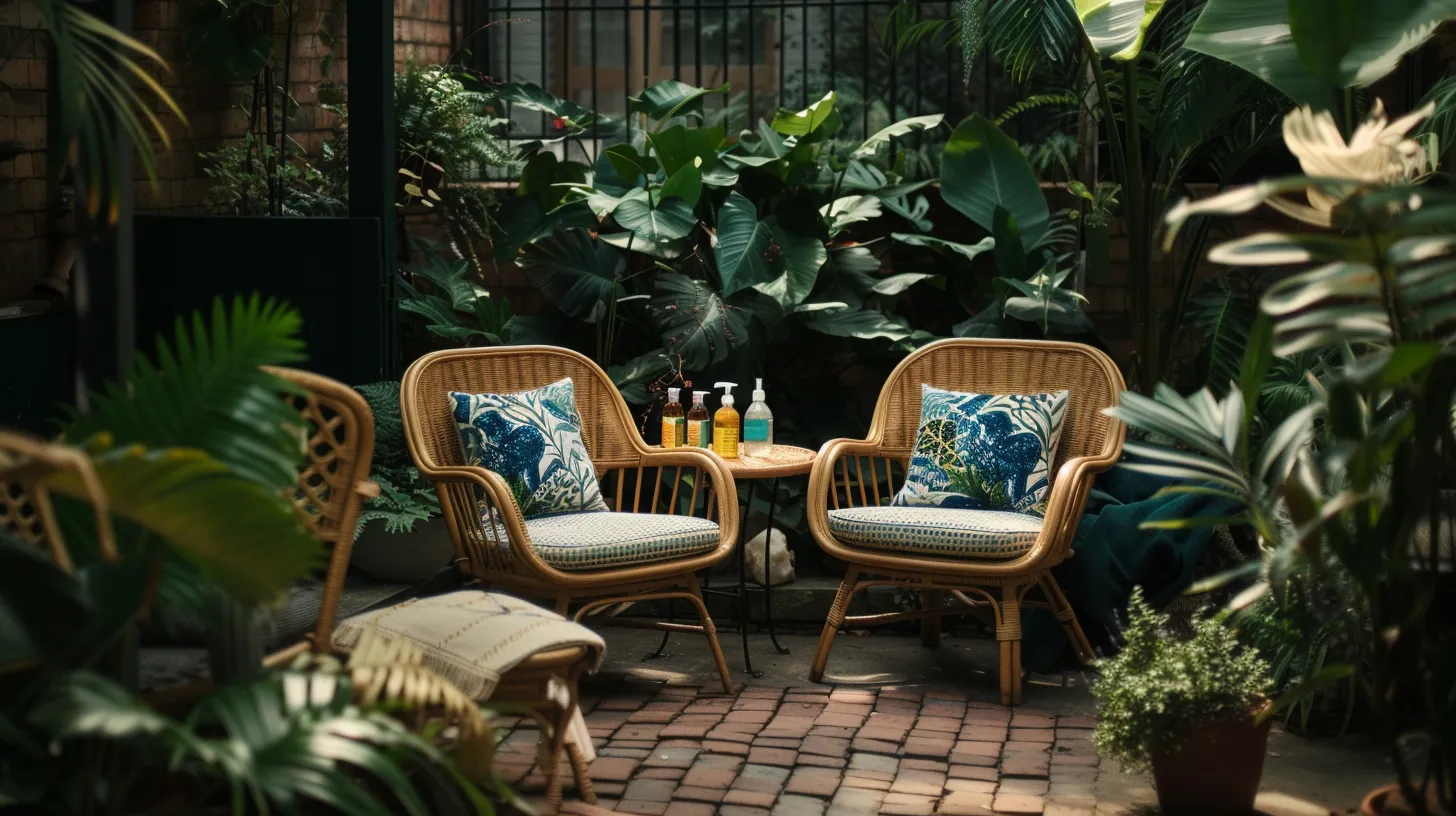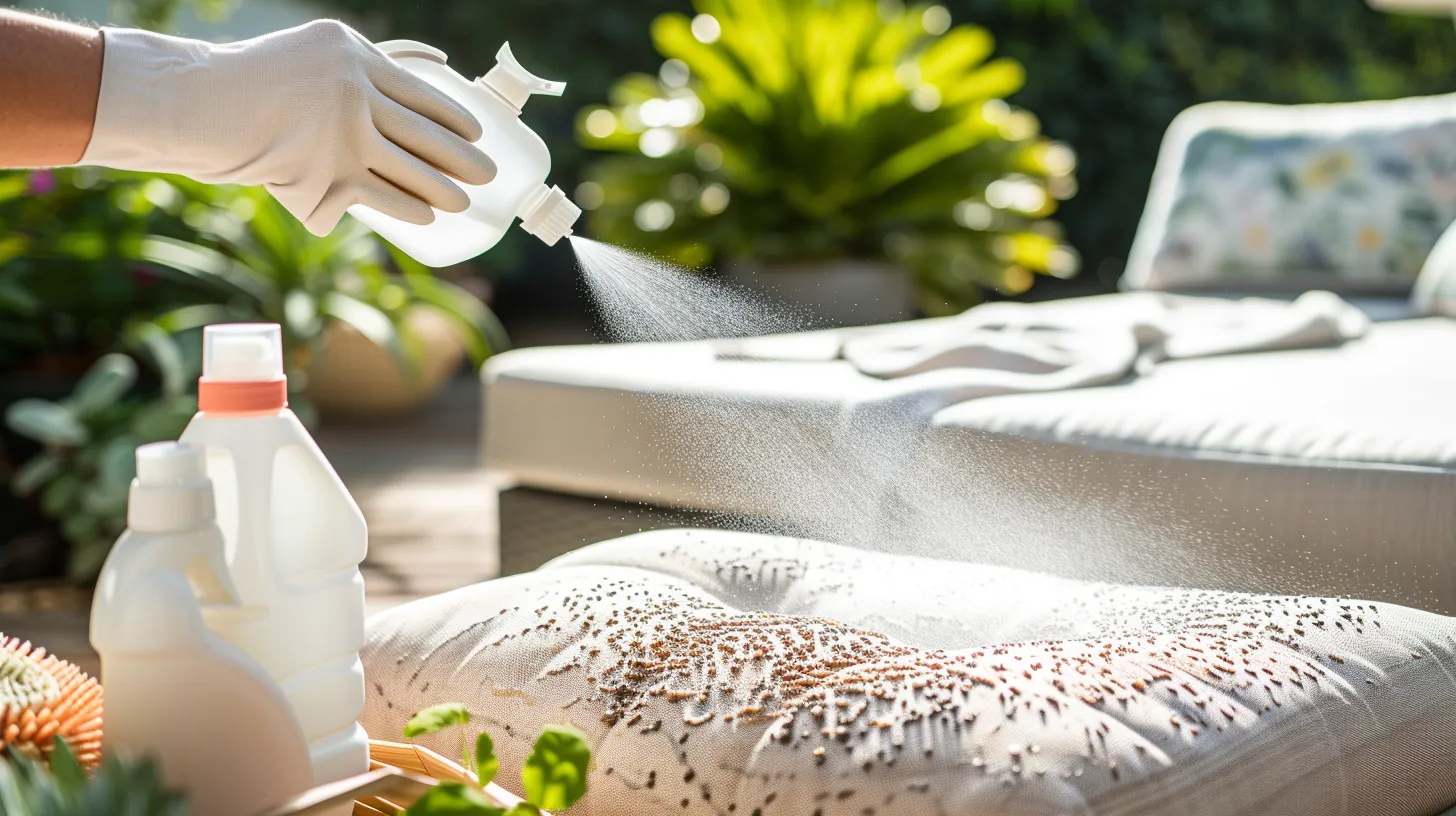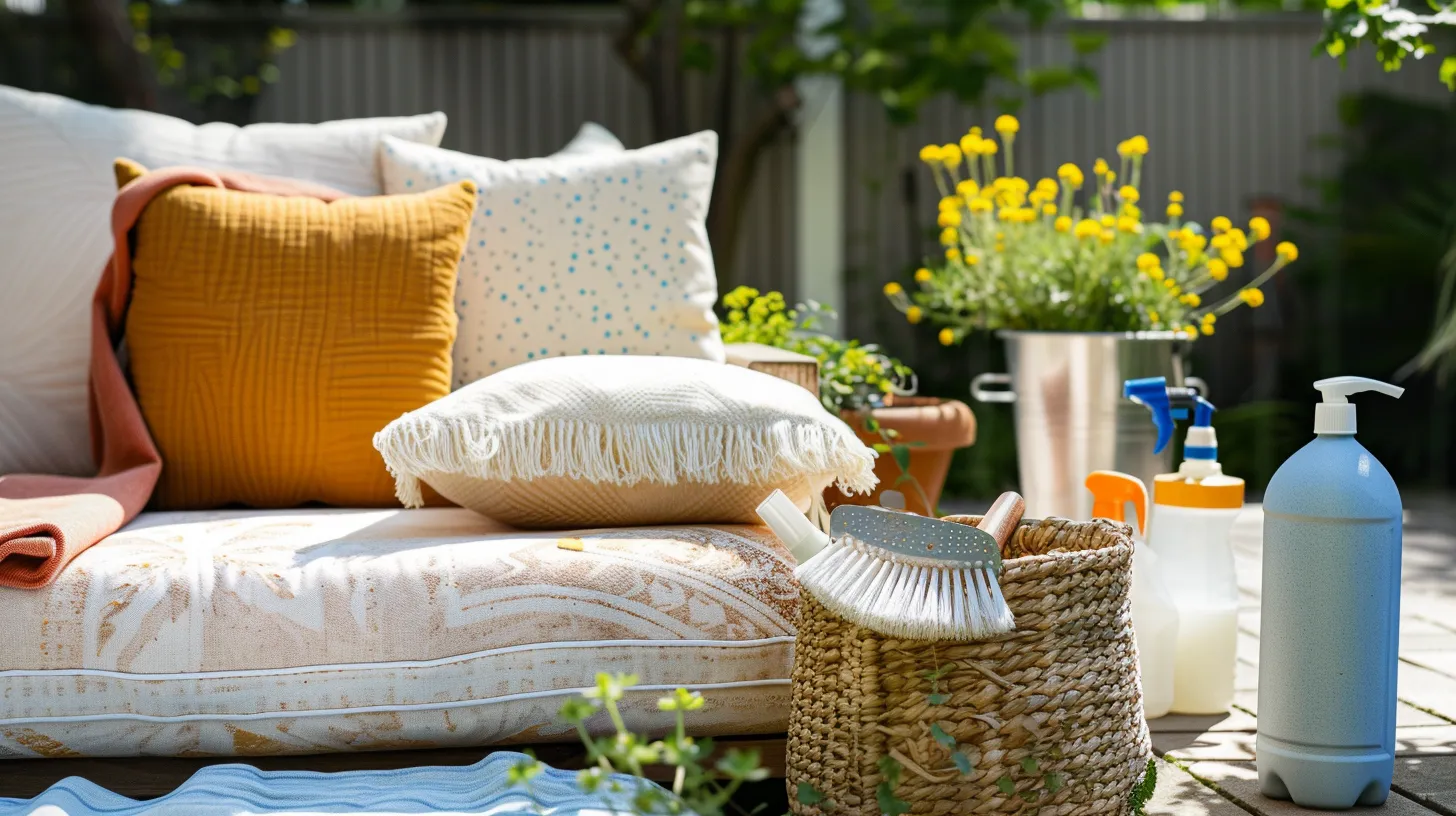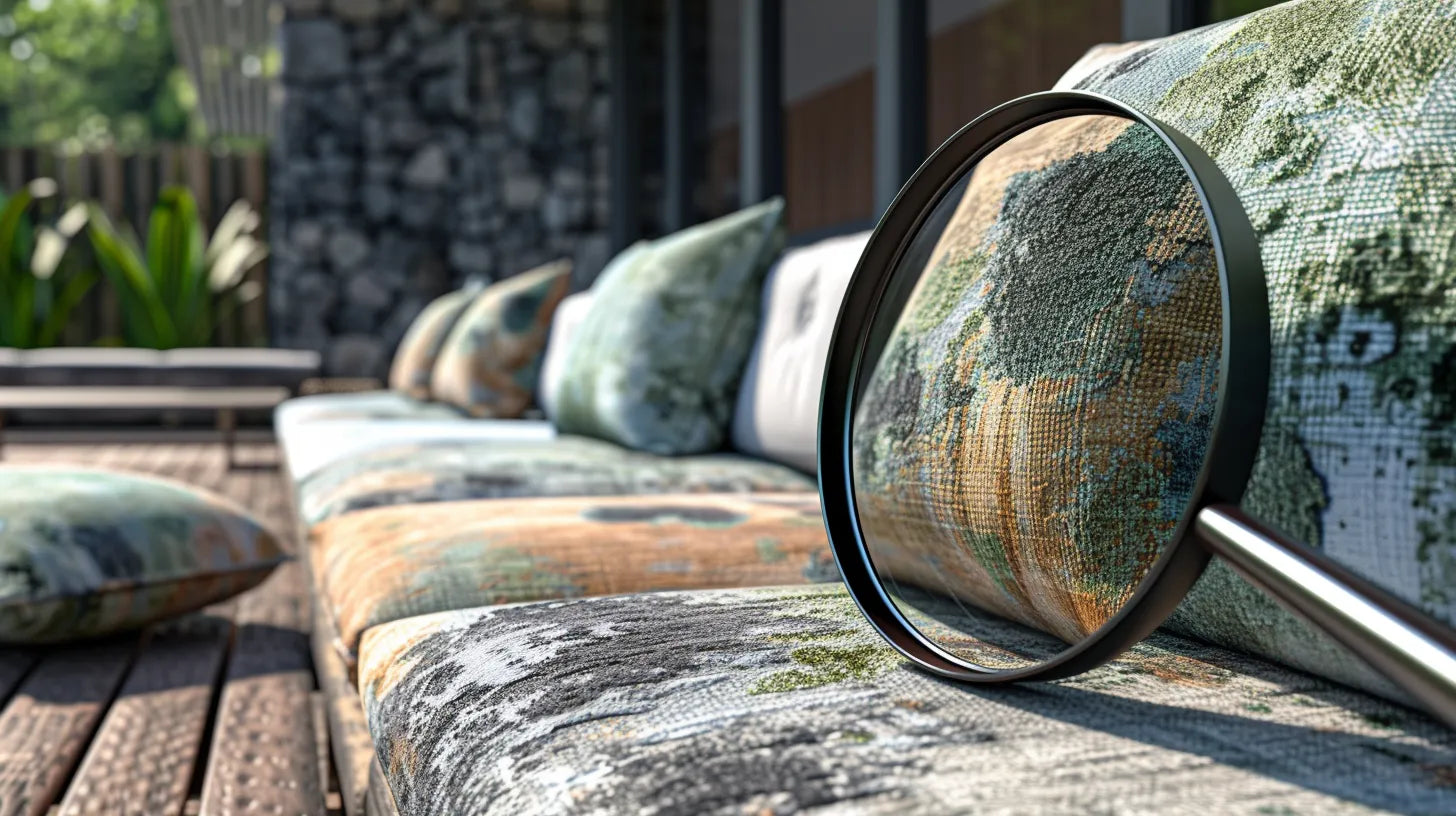The presence of mold on outdoor cushions not only detracts from the aesthetic appeal of your outdoor living spaces but can also pose health risks to individuals with allergies or respiratory issues.
While various cleaning methods, such as using vinegar or bleach solutions, have been widely recommended, it's crucial to approach this task with the right technique to ensure the longevity of your cushions and avoid damaging the fabric.
Moreover, understanding the preventive measures to inhibit future mold growth is equally important.
Engage in this discussion to explore comprehensive strategies for effectively tackling mold on outdoor cushions, and uncover tips that could safeguard your outdoor textiles against similar issues.
Identifying Mold

Recognizing mold on outdoor cushions involves looking for telltale signs such as black or dark spots, fuzzy growths, and detecting a musty odor, which are indicative of mold presence due to its preference for moist, warm, and dark environments. When it comes to outdoor cushions, these elements are often unavoidable, thereby creating a conducive habitat for mold to thrive.
The appearance of black spots or a fuzzy growth on the surface of the cushions is not just an aesthetic issue but also a health concern. Mold, by its very nature, can pose risks to personal health, especially when it comes to respiratory issues. Therefore, the detection of a musty smell, often described as earthy or dirty, should prompt an immediate inspection of outdoor cushions for mold.
Promptly addressing mold is not only crucial for the durability of the furniture but also for the well-being of individuals who use them. Cleaning mold off outdoor cushions at the earliest sign of infestation helps prevent its spread and safeguards the health of those in contact with the affected furniture. Ignoring these signs can lead to more significant problems, both for the cushions themselves and for personal health.
Prevention Tips

After identifying mold on outdoor cushions, it becomes imperative to explore strategies to prevent its occurrence altogether. The key to maintaining the pristine condition of outdoor furniture lies in adopting proactive measures. Regularly wiping down cushions with a clean, damp cloth can significantly reduce moisture accumulation, thereby preventing mold growth. For a more thorough clean, employing a soft brush and a mild soap solution can remove existing dirt and residues that may encourage mold formation.
Storing cushions in a dry, well-ventilated area when not in use is crucial. This practice not only wards off mold but also extends the lifespan of outdoor furniture. In regions prone to high humidity or unexpected rainfall, utilizing furniture covers or protective coatings offers an additional layer of defense against moisture intrusion.
Moreover, ensuring that outdoor spaces have proper drainage can prevent water from pooling on cushions, a common precursor to mold development. Lastly, the application of fabric protectants, such as 303 Fabric Guard, creates a formidable barrier against stains and mold growth. These spray-on solutions seal the fabric, making cushions less susceptible to mold, thus maintaining the integrity and aesthetics of outdoor furniture.
The Bleaching Method

Bleach serves as a powerful agent in disinfecting and eradicating mold from outdoor cushions, offering an efficient cleaning solution. Its effectiveness in removing fungi, bacteria, and germs makes it a go-to choice for homeowners seeking to restore the appearance and hygiene of their cushioned outdoor furniture. However, employing bleach requires adherence to safety precautions, including the use of protective gear to avoid harm from its potent chemical properties.
Before applying bleach, it's critical to test the fabric compatibility to ensure that the cleaning process will not damage the cushions. For non-removable cushion covers, a diluted solution of bleach and water can be applied directly to the affected area. Following the application, a thorough rinse and exposure to sunlight are necessary to maximize the disinfecting process and eliminate any residual mold spores.
In the case of removable covers, soaking them in a bleach solution, then proceeding with a regular wash cycle using detergent, effectively removes mold. The final step involves air-drying the covers, a crucial aspect that prevents the recurrence of mold by ensuring that the fabric is completely moisture-free. This comprehensive approach ensures the safe and effective removal of mold from outdoor cushions, restoring them to their original condition.
The Vinegar Solution

For homeowners seeking a natural and environmentally friendly method to combat mold on outdoor cushions, a vinegar solution presents a viable alternative. This approach, utilizing a simple mixture of white vinegar and water in a 1:1 ratio, leverages the natural antibacterial and antifungal properties of vinegar to effectively target and remove mold from furniture textiles. By applying the vinegar solution directly to the affected areas of outdoor cushions and employing a scrub brush, individuals can thoroughly address the presence of mold without resorting to harsh chemicals.
The process of cleaning mold from outdoor cushions with a vinegar solution is not only effective but also eco-friendly and non-toxic, making it an ideal choice for families and pets. After the application and scrubbing process, it is essential to rinse the cushions thoroughly to eliminate any residual vinegar solution. To ensure that mold does not regrow, allowing the cushions to sun dry is a critical step. The sun's UV rays aid in further disinfecting the fabric and ensure that the cushions are completely dry, preventing the conditions mold thrives in.
Maintenance and Care

Maintaining the cleanliness and integrity of outdoor cushions requires a proactive approach to care and routine upkeep beyond just addressing mold issues. Regular vacuuming of patio cushions is essential to remove dirt and debris, preventing the environment that fosters mold growth on outdoor furniture cushions. Additionally, treating these cushions with a fabric protectant forms a defensive barrier against moisture and stains, further safeguarding your patio furniture.
Storing cushion covers in a dry, well-ventilated area when not in use is crucial for mold prevention. It's important to avoid the use of harsh chemicals or bleach for cleaning outdoor furniture, as these substances can damage the fabric and inadvertently promote mold growth. Instead, opt for a gentle cleaning solution made with mild soap and warm water to tackle any dirt and stains. This solution, applied with a soft brush or cloth without high pressure, ensures a thorough clean without compromising the cushion's material.
Furthermore, the practice of flipping and rotating outdoor furniture cushions regularly facilitates even wear and prevents moisture buildup, a common precursor to mold and mildew. This routine maintenance not only extends the life of your cushions but also keeps them looking fresh and inviting for every outdoor occasion.










